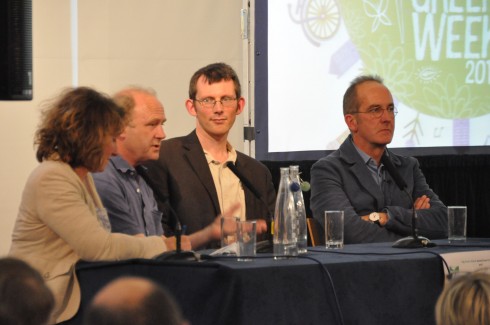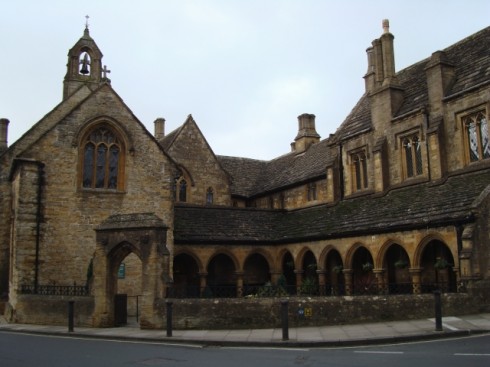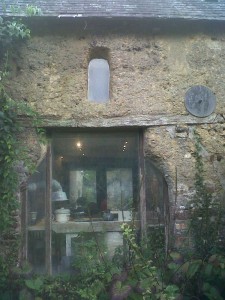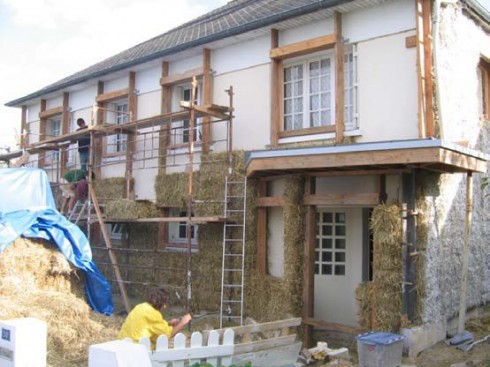Transition Culture has moved
I no longer blog on this site. You can now find me, my general blogs, and the work I am doing researching my forthcoming book on imagination, on my new blog.
Come find me at robhopkins.net
Archive for “Natural Building” category
Showing results 6 - 10 of 61 for the category: Natural Building.
14 Jun 2012

 I spent a very enjoyable day at Bristol Green Week yesterday. Green Week is a celebration of green ideas and thinking in Bristol, which has featured a wildly eclectic mix of talks, workshops, music, comedy, films, walks and much more. I arrived midway through the week’s festivities, to participate in two events. The first was a screening of ‘In Transition 2.0’, shown as the third in a series of films under the somewhat uninspiring banner of ‘Documentary Evidence’. Apparently Monday’s had attracted 30 people, and Tuesday’s just 4, so it was suggested that I might want to temper my expectations in terms of attendance. In the end over 40 people came, and the whole thing went really well.
I spent a very enjoyable day at Bristol Green Week yesterday. Green Week is a celebration of green ideas and thinking in Bristol, which has featured a wildly eclectic mix of talks, workshops, music, comedy, films, walks and much more. I arrived midway through the week’s festivities, to participate in two events. The first was a screening of ‘In Transition 2.0’, shown as the third in a series of films under the somewhat uninspiring banner of ‘Documentary Evidence’. Apparently Monday’s had attracted 30 people, and Tuesday’s just 4, so it was suggested that I might want to temper my expectations in terms of attendance. In the end over 40 people came, and the whole thing went really well.
Read more»
16 May 2012

What might we learn from the construction, between1438 and 1448 of the Hospital of St. John in Sherborne (see above) that might shape the way we think about construction in the 21st century? While the bulk of the building was built using local oolitic limestone, it was dressed with Lias stone from Ham Hill, some 12 miles from the building site. However, in those days, without the internal combustion engine, 12 miles was a long way to carry stone (you try it). The meticulous accounts kept of the project at the time show that the cost of transporting the stone by cart cost more than the stone itself. As Alec Clifton-Taylor says in his seminal ‘The Pattern of English Building’, “it was the great difficulty of transporting heavy materials which led all but the most affluent until the end of the eighteenth century to build with the materials that were most readily available near the site, even when not very durable”.
Read more»
26 Sep 2011
 I loved Ed Mitchell’s post over on the Transition Network site as part of the ‘fantastic ‘social reporters’ project. There are 12 ‘social reporters’ around the UK who will be blogging in a rota, producing one blog post every day, on a subject set by a guest editor at the beginning of the week. Ed’s was called “A liminal song of thanks”, and in it he wrote:
I loved Ed Mitchell’s post over on the Transition Network site as part of the ‘fantastic ‘social reporters’ project. There are 12 ‘social reporters’ around the UK who will be blogging in a rota, producing one blog post every day, on a subject set by a guest editor at the beginning of the week. Ed’s was called “A liminal song of thanks”, and in it he wrote:
“That’s why we’re staying up late, working on personal time, finding friends who don’t want to support this future, even though it seems unavoidable, and jamming with them, making it up as we go, sharing our personal stories, openly, our successes, our failures, our hopes, our dreams, our loves. Our vegetables. Wrestling with content management systems that aren’t as perfect as our hopes”.
Beautiful. No mention of making your own paint out of cheese though. So I thought I’d better put that right this morning.
Read more»
23 Sep 2011
 As part of last weekend’s Transition Town Totnes Open Eco-Homes weekend, I visited a house in Lower Allerton that was built in the 16th century, and which has recently been making many changes to reduce its environmental impact. As regular readers will know, I have done a fair bit of cob building in my time, and have often had to deal with the question “won’t it just wash away in the rain”, a question as infuriating to cob builders as Three Little Pigs jokes are to straw bale builders. The highlight for me, therefore, of the visit to Lower Allerton, was the 500 year-old cob walls.
As part of last weekend’s Transition Town Totnes Open Eco-Homes weekend, I visited a house in Lower Allerton that was built in the 16th century, and which has recently been making many changes to reduce its environmental impact. As regular readers will know, I have done a fair bit of cob building in my time, and have often had to deal with the question “won’t it just wash away in the rain”, a question as infuriating to cob builders as Three Little Pigs jokes are to straw bale builders. The highlight for me, therefore, of the visit to Lower Allerton, was the 500 year-old cob walls.
Read more»
5 Jul 2011

I have, on occasion, reflected here at Transition Culture about how the natural building movement, with its leaning towards natural building materials such as straw, clay, hemp and so on, has yet to really explore how those materials might be used to retrofit existing homes. Virtually all of the work done around those materials focuses on new build, but finally, it seems some work is happening on retrofits. An MPhil dissertation done at University of Cambridge by Keven Le Doujet entitled “Opportunities for the large scale implementation of straw based external insulation as a retrofit solution of existing UK buildings: how much of a good idea is it to externally insulate existing UK buildings with straw bales?” explores this very question. It is a fantastic and comprehensive piece of work which is a pleasure to read.
Read more»
 I spent a very enjoyable day at Bristol Green Week yesterday. Green Week is a celebration of green ideas and thinking in Bristol, which has featured a wildly eclectic mix of talks, workshops, music, comedy, films, walks and much more. I arrived midway through the week’s festivities, to participate in two events. The first was a screening of ‘In Transition 2.0’, shown as the third in a series of films under the somewhat uninspiring banner of ‘Documentary Evidence’. Apparently Monday’s had attracted 30 people, and Tuesday’s just 4, so it was suggested that I might want to temper my expectations in terms of attendance. In the end over 40 people came, and the whole thing went really well.
I spent a very enjoyable day at Bristol Green Week yesterday. Green Week is a celebration of green ideas and thinking in Bristol, which has featured a wildly eclectic mix of talks, workshops, music, comedy, films, walks and much more. I arrived midway through the week’s festivities, to participate in two events. The first was a screening of ‘In Transition 2.0’, shown as the third in a series of films under the somewhat uninspiring banner of ‘Documentary Evidence’. Apparently Monday’s had attracted 30 people, and Tuesday’s just 4, so it was suggested that I might want to temper my expectations in terms of attendance. In the end over 40 people came, and the whole thing went really well.





